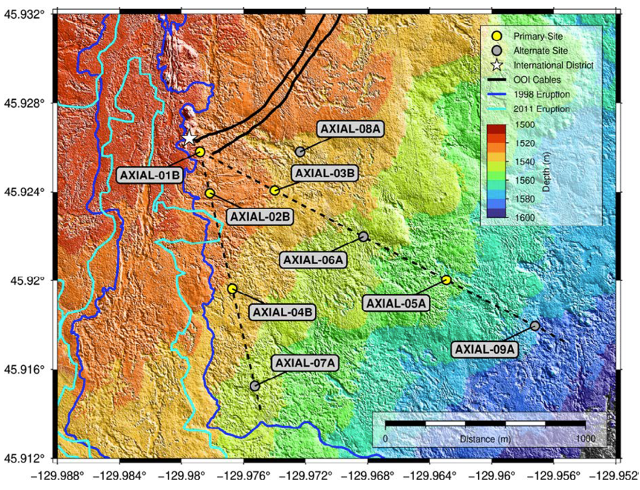Facilitating Observatory-Based Subseafloor Science
Julie A. Huber, Marine Chemistry and Geochemistry, Woods Hole Oceanographic Institution, Woods Hole, MA, Timothy J. Crone, Lamont-Doherty Earth Observatory, Columbia University, Palisades, NY, USA, and Dax Soule, School of Earth and Environmental Sciences, Queens College – CUNY, Flushing, NY, USA. Extracted from OOI Science Plan, 2021.
As much as 80% of the volcanism on Earth occurs beneath the ocean’s surface, and seafloor hydrothermal systems impact global ocean chemistry and heat budgets, and host novel microbial ecosystems that provide insight into biogeochemistry in the deep ocean, origins of life on Earth, and potentially into other ocean worlds of our solar system. Axial Seamount is located on the Juan de Fuca Ridge and is the most active submarine volcano in the northeast Pacific, having erupted most recently in 1998, 2011, and 2015 and forecasted to erupt again in 2022–24 (e.g., Wilcock et al., 2018). For nearly 30 years, Axial has been the focus of interdisciplinary studies aimed at understanding linkages between magmatic cycles, subseafloor hydrology, hydrothermal vent formation and geochemistry, heat and chemical fluxes, as well as the diversity and evolution of microbial and animal communities. As part of the NSF’s OOI Regional Cabled Array (RCA), Axial now supports a suite of geophysical, chemical, and biological sensors and experiments that stream data to shore. An important aspect of the OOI is that the data can provide the environmental conditions and background within which to propose ancillary, process-based studies. Here, we highlight how the six-year record of real-time data flowing from the RCA forms an unparalleled foundation on which to build one such ancillary study: an ocean drilling program with the International Ocean Discovery Program (IODP) to understand the relationships between microbial, hydrological, geochemical, and geophysical processes in zero-age, hydrothermally active oceanic crust.
Proposed Axial drilling will provide a unique opportunity to determine the nature of subseafloor hydrological properties and processes, quantifying their influence on fluid flow patterns, associated heat and solute fluxes, reactive transport processes, and their collective impact on fluid and crustal evolution, oceanic geochemical cycles, and microbiological activity in young oceanic crust (Huber et al., 2017). For example, there is very little information about the in-situ extent of the subseafloor biosphere in zero-age oceanic crust; most available data are from venting fluids and seafloor deposits (e.g. Fortunato et al., 2018). Future work at Axial using ocean drilling and the RCA will enable researchers to determine the distribution and composition of crustal subseafloor microbial communities, their association with mineral surfaces, rates of activity, and role in biogeochemical cycling of carbon, iron, nitrogen, hydrogen, and sulfur. Furthermore, through these coordinated efforts scientists will be able to determine the 4-D architecture of an active hydrothermal system and understand how the connectivity of the hydrological, chemical and physical properties of the upper oceanic crust are linked to magmatic and tectonic deformation through a volcanic cycle. While multiple sites have been drilled along fluid flow pathways in older oceanic crust, drilling at Axial, coupled to the RCA, will help to develop a 3-D understanding of subseafloor processes in unsedimented crust. This is unprecedented.
Scientists have proposed drilling operations adjacent to the Axial RCA, that will enable the creation of a network of drill holes in an area of active hydrothermal circulation, leveraging drilling activity many times over: facilitating interactive observatory-based subseafloor science, installing instrumentation and connecting it to the RCA post-drilling, and allowing for novel manipulative experiments, real-time long-term monitoring, and cross-hole studies (Figure to the right), (IODP Proposal 955-Full, currently in revision). Importantly, the perturbation of drilling itself, coupled to monitoring at nearby vents during and after drilling, will enable inferences of permeability, fluid flow dispersion patterns, subseafloor mixing, and responses of microbial communities. Real-time assessment of drilling-induced disturbances and post-expedition downhole experiments and investigations will be unparalleled because of the real-time data flowing from the RCA at Axial. By combining the OOI assets at Axial with the ocean drilling program, this cutting-edge infrastructure will provide a legacy to serve mid-ocean ridge scientists for decades to come.

